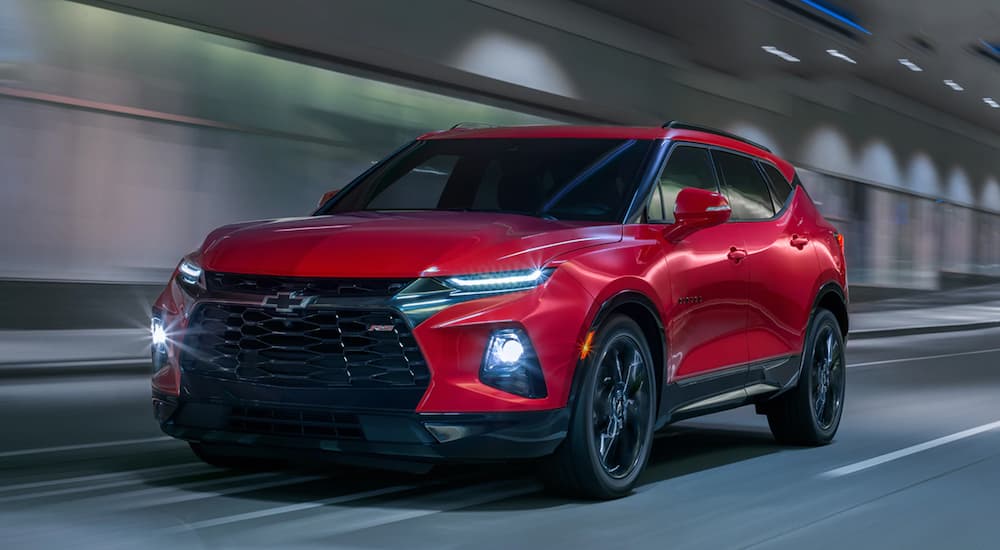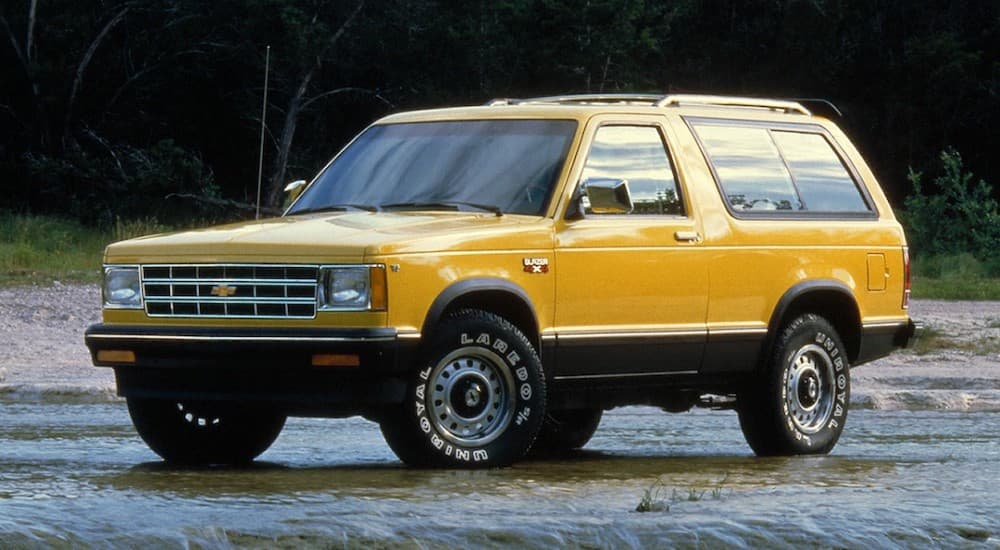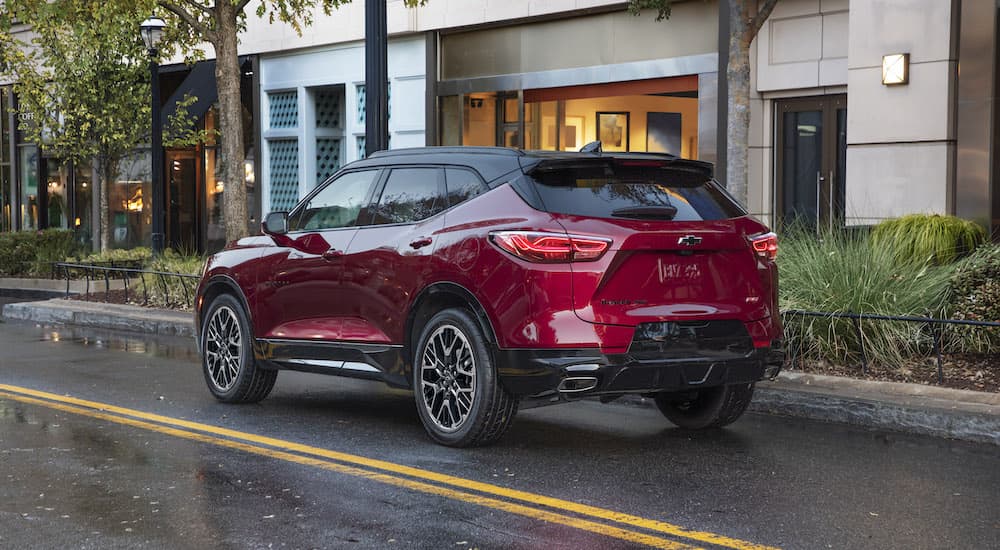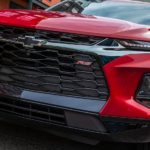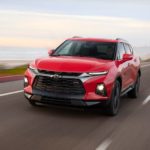1970s America was an era of social progress, disco, bell-bottoms, duos like Sonny and Cher, bombshells like Charlie’s Angels, and television families like the Partridges. It was also a period of vast advancement in the automotive industry, especially with International Harvester’s debut of the Scout a decade prior. As the first rugged, passenger-carrying four-wheel drive vehicle, the Scout ignited a new trend in the American automotive landscape, forcing automakers like Ford and Chevrolet to respond with models like the Bronco and Blazer, adventurers of epic proportions.
Any trip to your local Chevy Blazer dealer will introduce you to the modern version of the SUV, a model that reintroduced itself amid a social media craze and a growing need for speed. As you might’ve guessed, this Blazer is far different from the early model built in response to the Scout and Bronco. The first-generation Blazer was a bare-bones off-road rig that gained an edge over the competition with its massive cabin and capability, making it ideal for families with a penchant for adventure. Today, the differences are remarkable and usher the SUV into a new era where its Camaro-inspired design meets cutting-edge technology and too many conveniences and luxuries to count.
A Blast from the Past: Meet the Original Blazer
As soon as the Scout debuted, GM quickly got to work on a rival model, initially slating its debut in 1966. However, GM market analysts pulled the plug on the project, citing that the niche market wouldn’t make up for the production costs. Fast forward a few years later and Chevrolet’s chief truck engineer, Paul Hitch, had a moment of brilliance. He suggested taking Chevrolet’s half-ton truck and shortening it to form a two-door wagon.
Hitch’s idea stuck, and Chevy developed the first iteration of the Blazer in 1968. By using the truck platform, Chevy engineers trimmed the Fleetline truck’s wheelbase from 115 inches to 104 inches and added a removable composite top. These minor changes made the 1969 Blazer incredibly affordable to make, setting the rugged SUV up for a bright future in the Chevy fleet.
The Blazer’s larger size and more capable powertrains immediately distinguished the SUV from the Bronco. But, more importantly, Chevy’s multi-engine lineup made the Blazer more enticing, especially with the availability of a small-block 350ci engine that delivered 255 horsepower and a launch from 0 to 60 mph in 11 seconds. The Bronco’s V8 engine couldn’t manage such a feat, taking 14.5 seconds to reach 60 mph.
Beyond this impressive power, the Blazer’s options for customization also made the SUV attractive to drivers looking for a larger and more capable rig to meet their needs. For example, you could get the 1969 KS or KE Blazer without a top and with only a driver’s seat. In addition, you could add front bucket seats and a removable rear seat or upgrades like power steering, air conditioning, and power drum brakes. These features added versatility to the Blazer, guaranteeing its popularity among American drivers looking for more ways to answer the call of the wild.
The End of an Era (Or So We Thought)
The Blazer’s popularity lasted into the 1980s when Chevrolet sparked new interest in the SUV with the debut of the smaller S-10 Blazer. This rejuvenated Blazer sales, carrying the SUV into the 1990s when its larger sibling, the Tahoe, made its debut. By 2005, the Blazer bid a fond farewell to the Chevy lineup, but how much had it changed by then?
By the new millennium, the Blazer was offered in two and four-door options with two available powerplants––a 4.3L V6 that delivered 200 horsepower and 260 lb-ft of torque or a 195-horsepower V6 engine that produced 250 lb-ft of torque. This power, which was comparable to the first-generation Blazer, was only bettered by the Blazer’s increased ground clearance, exclusive off-road features like Bilstein shocks and underbody skid plates, and an array of updated technology like cruise control and navigation. Additional luxuries like leather seating, power front seats, and a CD player made the final iteration of the Blazer far more luxurious and innovative than the bare-bones model of the late 1960s and early 1970s.
From Bare-Bones to Sporty Crossover: The Icon Returns
Have you ever heard the phrase, “Why reinvent the wheel?” Automakers have long subscribed to the adage, using their best-selling platforms to introduce new models or updated designs. We saw this firsthand in 2019 with the return of the Blazer, a modern take on the 1969 icon renowned for its spacious cabin and capability.
Chevrolet didn’t reinvent the wheel with the 2019 Blazer, but the automaker certainly polished it and made it look less like a wagon wheel or more like a high-performance version you’d see on the road today. Bidding a fond farewell to the Blazer’s boxy design and body-on-frame truck platform of its former life, the 2019 Blazer reintroduced the icon as a sporty crossover with a Camaro-inspired design and unibody construction. Its wider stance and dramatic sculpting gave it a more athletic appearance, while its signature horizontal grille acknowledged its past.
Fast forward several years, and the newest iteration of the Blazer continues to impress in 2022. Available in three trims and all-wheel drive, the Blazer blends luxury with capability and versatility, proving drivers can have it all in an SUV. But how does it measure up to the Blazer of decades past? Its standard 2.0L turbocharged four-cylinder engine delivers 228 horsepower and better fuel economy than any Blazer in history, with an average of 22 MPG in the city and 29 MPG on the highway. Older models were lucky to average 11 MPG, making the newest Blazer even more enticing.
Chevy’s ingenious engine design remains a staple in the Blazer lineup, especially when opting for the 3.6L V6 engine with the nine-speed automatic transmission. This powerplant comes standard on the performance-inspired RS trim and delivers 308 horsepower, over 100 more horses than the 2005 Blazer. This power and performance aren’t mutually exclusive with efficiency, as the 3.6L averages 19 MPG in the city and 27 MPG on the highway.
Beyond power, the 2022 Blazer further distinguishes itself from its predecessors with a suite of cutting-edge technology that ushers the SUV into a new era of innovation and agility. The K5 Blazer of the 1960s and 1970s wouldn’t know what to do with the 2022 model’s expansive center touchscreen display or driver-assist tools like Forward Collision Alert and Automatic Emergency Braking. Back then, a rearview camera and virtual assistants like Alexa were unheard of, tasking drivers to rely on their passengers as virtual spotters and navigators. In other words, you can forget those “recalculating” prompts from sweet-talking computers and think along the lines of a disgruntled copilot yelling, “You missed the turn,” in more colorful language.
The Legend Continues
The Blazer remains a staple in Chevrolet’s current lineup and proves that you can reintroduce an icon, but it’s harder to revive it to its former glory. What do we mean? The Blazer was designed on a truck platform, giving it its capability, practicality, and expansive cabin. These three characteristics distinguished the Blazer from rivals like the Scout and Bronco, sealing its fate as a top choice in the segment throughout the 1970s and 1980s.
The Blazer’s reintroduction in 2019 brought with it several notable changes. First, the former legend exchanged its truck-like platform for a unibody construction that likened it more to a sedan than a capable off-road warrior. For purists, this was nearly sacrilegious because it stripped the Blazer of its true identity. However, for Chevrolet, it proved to be a wise move.
The newest iteration of the Blazer builds on its previous life, starting a new chapter that’s less oriented with ruggedness and more inclined to luxury and sophistication. Its all-wheel drive capability enhances its handling in various conditions; still, it’s destined to perform on the pavement and attract drivers looking for a sport-like icon that will deliver luxury and convenience at every turn. This modern Blazer serves an entirely different purpose, answering the demand for luxury and on-road agility rather than the wild adventures that require traveling beyond the pavement.
